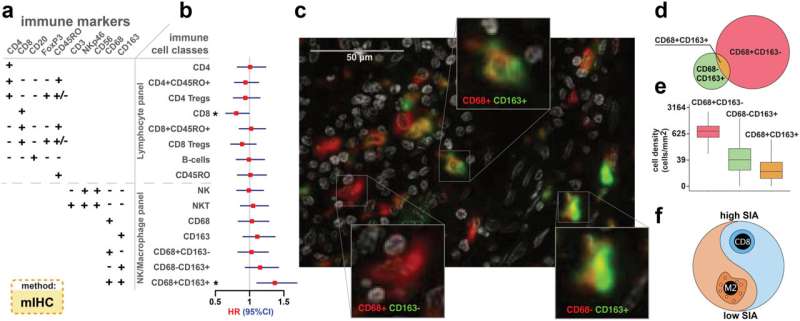This article has been reviewed according to Science X's editorial process and policies. Editors have highlighted the following attributes while ensuring the content's credibility:
fact-checked
peer-reviewed publication
trusted source
proofread
Method that uses combination of immune cells could provide clearer prognoses

Thanks to a new prognostic method for detecting cancers including cancer of the large intestine, doctors could provide clearer disease prognoses and predict which patients will respond best to immunotherapy. The method consists of a combination of two types of immune cells that characterize certain forms of cancer. This has been shown in a new study by researchers at Uppsala University to be published in the journal eBioMedicine.
The immune system is highly complex and involves a large number of cell types. In recent years, the importance of the immune system in cancer has become increasingly evident. Immune cells are part of the environment surrounding the tumor, where they can support or suppress tumor growth. Various forms of immunotherapy are being used successfully to treat several types of cancer.
However, some tumors do not respond to immunotherapy. Researchers at Uppsala University have now identified a combination of specific immune cells that could be used to provide a prognosis and to predict treatment response to immunotherapy for certain types of cancer. The ability to say in advance which patients will gain the most benefit from immunotherapy, doctors can avoid treating the group that currently experiences severe side-effects without the desired outcome.
"We started by mapping 15 different immune cells in tumor samples from patients with colorectal cancer. The presence of one specific type of macrophage and one kind of T cell were found to be associated with patient fate," explains Artur Mezheyeuski, researcher at Uppsala University and first author of the study.
Based on the presence of the macrophage and one type of T cell, the researchers developed a prognostic method which they named a Signature of Immune Activation, or SIA. They also found a correlation between SIA and disease progression in cancer of the large intestine and rectal cancer, but also several other of the most common cancer forms.
"It is relatively simple to determine SIA and it functions as an independent biomarker for at least five different cancer forms. It also works better than other prognostic methods based on immune cell analysis," adds Mezheyeuski.
The study showed that SIA can also be used to predict treatment response to immunotherapy. When the researchers analyzed samples from patients affected by a malignant melanoma that was treated using immunotherapy, they noticed that patients with high SIA values responded better to the treatment.
"We believe that our results should be further evaluated in prospective studies, to demonstrate that SIA can be used for selecting patients that are likely responders to different immunotherapies," says Tobias Sjöblom, professor at Uppsala University, who led the study.
The macrophages that were part of the SIA had unique features, suggesting them as potential therapeutic targets. This kind of treatment could be combined with immunotherapy, and SIA could also be used to define the patients that could benefit from this combination.
More information: Artur Mezheyeuski et al, An immune score reflecting pro- and anti-tumoural balance of tumour microenvironment has major prognostic impact and predicts immunotherapy response in solid cancers, eBioMedicine (2023). DOI: 10.1016/j.ebiom.2023.104452





















